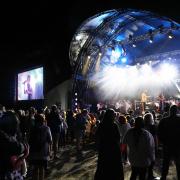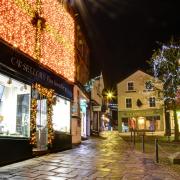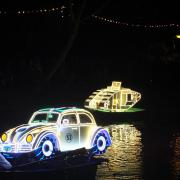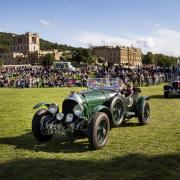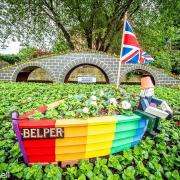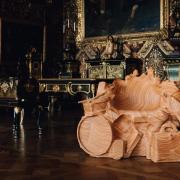Although the war broke out only eleven years after the initial flight of the first frail and flimsy aeroplane, by 1914 the aircraft had developed as a serious weapon of conflict, first as a reconnaissance and photographic tool, then a primitive bombing machine and finally as a fighter or scout

We should remember in this centenary year of the outbreak of the Great War that many Derbyshire servicemen did their duty in the nation’s air forces, either in the air or on the ground. Few achieved fame, but a glance through the local newspapers of the time show that considerable numbers fought, and sometimes died, to rid the world of the menace caused by an unstable monarch’s vaulting ambition. Although the war broke out only eleven years after the initial flight of the first frail and flimsy aeroplane, by 1914 the aircraft had developed as a serious weapon of conflict, first as a reconnaissance and photographic tool, then a primitive bombing machine and finally as a fighter or scout. Piloting flying machines that were built of little more than wood and doped canvas, held together with wing struts and bracing wires, early military aviators were aerial gladiators in perhaps the truest sense. The infant technology and tactics tested their skills and courage to the utmost as they virtually learned on the job.
Warplanes became sturdier and more reliable as hostilities continued and by 1916 the fighter had become a state-of-the-art killing machine. Until that year, British and Commonwealth pilots, operating with the Royal Flying Corps (RFC) and the Royal Naval Air Service (RNAS), had been handicapped by a failure, largely the fault of High Command, to utilise a fixed machine-gun mounted on the engine cowling and capable of firing through a fighter’s propeller, as the Germans had done a year earlier. Once this technical problem had been overcome, her scout pilots began achieving aerial victories that led many to acehood – the downing of five or more enemy aeroplanes.
Derbyshire’s leading ‘ace’ was John Leacroft, a doctor’s son from Derby, who, in two spells with 19 Squadron RFC destroyed 22 German warplanes. Leacroft had served pre-war in the OTU at his Cambridge college, and was a keen sportsman. He joined the ASC on the outbreak of war, remustering to the RFC and serving as an observer with 14 Squadron in Egypt. Accepted for pilot training, he gained his ‘wings’ in March 1917 and was posted to 19 Squadron in early May, where he flew the French-built SPAD VII, a rare type for the RFC, but one he flew skilfully and well. Between mid-June and the end of October he claimed 14 enemy victims, and was then rested as a flight commander with the award of the Military Cross.
Leacroft was posted back to his old unit in February 1918, where he found that the SPADs had been replaced with the Sopwith Dolphin, a brand-new type which he described as ‘a very good fighting machine.’ Between March and May, by which time the RFC and RNAS had been amalgamated to form the Royal Air Force, John added a further eight victims to his tally. He survived some hairy moments, including an inverted crash-landing near Passchendaele after a clash with a Fokker Triplane, and another force-down in the Australian front lines, when his fighter cut their telephone wires in the process, to their undisguised chagrin. Leacroft left 19 Squadron in June, with 22 ‘kills’ to his credit, and a bar to his MC, which seems scant reward for his undoubted success. John remained in the post-war RAF, ending his service as a group captain in 1945. He died in 1971 at the age of 82.
Close behind Leacroft in the victories table was Edwin Swale from Chesterfield, son of a local outfitter and councillor. Born in 1899, Edwin joined 10 Squadron RNAS in March 1918, a unit equipped with Sopwith Camels, the cutting edge of British fighter design. After 1st April, the first birthday of the RAF, the squadron was renumbered 210. Edwin spent his early weeks strafing and bombing advancing German troop units, and did not open his account until late May. Between then and early October, in one extended period of service, he added a further 16 hostile warplanes to his score. By his own account his most dangerous sortie was when he was hit at 18,000ft by enemy anti-aircraft fire. He nursed his badly damaged scout back to base and upon landing the whole aircraft literally collapsed round him, leaving it a complete write-off. Another dangerous mission was a dawn attack, on 13 August, on a German airfield at Varsenare, by several squadrons, which caught the enemy totally unprepared, and resulted in the destruction of parked aeroplanes, hangars and stores.
Swale was awarded a Distinguished Flying Cross in September, followed by a bar in late October. He served in the RAF in World War Two as a wing commander connected with ‘Ultra’ code-breaking intelligence, and became an alderman, JP, mayor and honorary freeman of his native town. He was awarded an OBE in 1958, a CBE six years later and died in 1978, unlucky not to have received a knighthood for his service in war and peace.
Herbert Victor Rowley, born in 1897 in Crich, was a vicar’s son who joined the RNAS in 1916. He was posted to ‘Naval 1’ Squadron in early 1917 where he flew Sopwith Triplanes, a unique design at the time, and an aircraft which could both outmanoeuvre and outclimb the German Albatros scouts which hitherto had held a marked advantage over British fighters. This machine only ever served with naval units, and its iconic design was so revolutionary that Germany’s Dutch designer, Anthony Fokker, produced a copy, the DR1 Dreidekker, in one of which the German ace Richthofen, met his death.
Between the end of April and mid-November Rowley claimed five victories, though he was once shot-up himself and had to force-land near Bethune. After a rest from operations he returned to the unit in early 1918, by which time it had re-equipped with the potent Sopwith Camel. Within three weeks in March/April he gained four further ‘kills,’ including an observation balloon – the most difficult and well-protected of targets - to give him a final total of nine, the last scored on the day the RAF was created. Rowley remained in the Service post-war, pioneering inter-war flights and ending his career as an air commodore, serving as AOC to 221 Group in the India/Burma theatre in 1943. He died in 1966 in his 69th year.
In fourth place in terms of enemy aircraft destroyed, and perhaps the most noted, was William Arthur Bond, another Cestrefeldian born in 1889 and famed in his wife Aimee’s best-seller An Airman’s Wife, published after his death in 1917. Bill was a newspaperman who joined the army in 1914 and was commissioned and awarded the Military Cross in 1916. He transferred to the RFC and was posted to 40 Squadron in the spring of 1917. The unit deployed the nimble, fast-climbing French-built Nieuport 17, and Bond, whose letters to his wife dramatically evoked the ethos of air fighting over the Western Front, claimed six enemy aircraft and an observation balloon in May/June of that year. He received a bar to his MC but was tragically killed on 22nd July when a lucky hit from enemy anti-aircraft fire blew his machine apart, whilst he was leading his flight near Lens. His body was never found, and Aimee subsequently wrote her book, much of it based on his daily letters. It was re-edited and annotated by myself, and republished by Grub Street in 2005.
Cyril Askew Eyre, the son of a retired grocer, was born in Codnor in 1896. Oxford educated, he was working in Canada where he joined the RNAS in 1915. By June of the following year he became operational with ‘A’ Squadron (later Naval 1) flying Sopwith Pups. They were soon replaced with the more effective Triplane, and between May and July Cyril, flying alongside Herbert Rowley, despatched six enemy warplanes, including a DFW CV which force-landed near Ypres, where it was captured by British forces. Sadly on 7th July Cyril was shot down and killed in a dogfight over Comines and lies buried in the Pont-du-Hem military cemetery at La Gorgue. Even more tragically his younger brother Edward Geoffrey, who followed him into the service, was killed just over three months later, flying Camels with Naval 4. His aircraft fell near Ichteghem on 21st October, and his body was never found. He is remembered on his brother’s tombstone which bears the legend ‘IN THEIR DEATHS THEY WERE NOT DIVIDED.’ Their joint loss must have devastated their widowed mother.
Another probable ‘ace’ was Frank Woolley, born in Ilkeston in 1899, son of a tradesman, and later an alderman and mayor of the Borough. Frank’s son, Frank Geoffrey, became a noted fighter pilot in World War Two, earning himself a double DFC. Frank senior volunteered for the army in mid-1917, but transferred to the RFC shortly afterwards. After training he joined 79 Squadron in July 1918, flying Sopwith Dolphins. Between then and the end of the war he claimed four official victims, though he believed he had destroyed nine, and the local Ilkeston press credited him with eight. Unfortunately the unit’s operations records book for the period has not survived, and after his death in 1981 his wife saw fit to burn his 1918 diary. Sadly his first logbook was also lost, so this eventful period in his life, when he was also forced down three times himself in combat, remains unrecorded.
Frank won the DFC and Belgian Croix de Guerre during the conflict, and remained in the RAF, winning the OBE for his work as a special service officer in Iraq in the 1920s, and adding the CB and US Legion of Merit at the end of the Second World War during which he was involved mainly in air intelligence. He achieved the rank of air commodore and retired from the Service in 1954.
Let us not forget either three early gallant local aeronauts who died tragic deaths without perhaps achieving the laurels they deserved. Frederic George Alleyne Arkwright, born in Cromford in 1885, was a professional soldier who joined the RFC as an observer after taking part in the early engagements fought by the British Expeditionary Force. He served with 8 Squadron in 1915, surviving a crash-landing in his BE2C on 4th June. He returned to England to retrain as a pilot, obtaining his ‘wings’ on 21st September at Montrose in Scotland. Sadly on 13th October his motor gave trouble on a solo flight and he landed near Glamis Castle. Following repairs next morning he took off as a passenger, a flight witnessed by the young Lady Elizabeth Bowes Lyon, Britain’s future queen. She saw the Farman trainer fall out of the sky, killing both occupants. Fred was buried at Cromford in a military ceremony witnessed by hundreds, his grave marked by a stone column surmounted by a cross.
Gilbert Sudbury Hall, born in Matlock in 1890, qualified as a motor engineer, and was a noted motorcyclist who took part in many speed and hill-climbing contests. He joined the army in 1915 before transferring to the RFC and qualifying as a pilot in early 1916. Gilbert ‘accounted for more than one enemy aircraft’ according to the local press, before resting back home with a slight wound. He joined 18 Squadron in early November, piloting a lumbering two-seat Vickers FE2B ‘Gun Bus’. Unfortunately on the 20th of the month he met Manfred von Richthofen near Bapaume, and was shot down. His observer was killed and Gilbert lingered, mortally wounded, until the 30th when he succumbed to his wounds. He was buried near Cambrai, and a stone in St Giles churchyard, Matlock, was later erected to his memory.
Another early local flier was William Eric Nixon, son of the vicar of Winster, who was born in 1897. Bill volunteered for the army in 1915, before transferring to the RFC late in the year. He served as a fighter scout in both 32 and 24 Squadrons in 1916, flying Airco DH2 ‘pusher’ biplanes. He survived many desperate actions, once involving combat with several Fokker E1 monoplanes, who riddled his warplane and wounded him in the arm. On three occasions in September he force-landed, once with a smashed propeller, and once after being hit in the petrol tank.
Nixon was wounded by anti-aircraft fire on 21st October, and spent some time in training duties at home before returning to combat flying on 4th May 1917, piloting Nieuport 17s with 40 Squadron. It was his misfortune to die only three days later, shot down by German ack-ack fire during a desperate squadron attack on enemy observation balloons near Lens. He was buried at Masny, a ‘gallant young officer’ twice Mentioned in Despatches for his many operational flights against a technically superior foe.
It is important that these all-but-forgotten heroes receive the honour they deserve as we remember their sacrifices. The words ‘Lest We Forget’ are as appropriate today as they were one hundred years ago.






